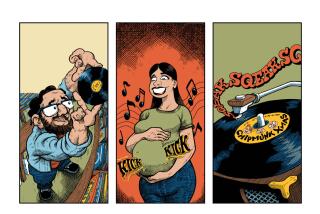Sound Effects
- Share via
When digital sound arrived on the consumer scene a little more than a decade ago, it was hailed as the second coming, the age of enlightenment in audio. But from the day of digital’s debut, audio magazine writers and others have carped about sound quality.
Some die-hard audiophiles, who sit around listening exclusively to aging vinyl, muttering about audio conspiracies and the vapidity of binary code, will never accept compact discs. Meanwhile, other music lovers have attempted to make the best of digital.
For a growing number who don’t mind putting serious money into home audio, that means reintroducing vacuum tubes into audio components, one of the latest methods designers are using in the never-ending attempt to educe perfect sound, whether from vinyl or silicon. Not exactly Luddites, these tube-o-philes just embrace an older--some would say superior--technology. Tubes, revered for the “warmth” they were said to impart, were the heart of audio components until transistors replaced them in the solid state ‘60s.
For people with low-end audio systems, CDs and CD players were a definite improvement over scratchy records played on cheap turntables. Some audiophiles, though, swore by vinyl, which has an analog signal encoded in the record’s grooves, waiting to be released by the delicate caress of the diamond stylus. These people used words like “harsh” and “sterile” to describe what they heard when they spun CDs.
Until they discovered a generation of CD players that incorporated vacuum tubes.
Typically, the CD players using vacuum tubes are divided into two separate units: the transport, which spins the CD and reads it with a laser, and the processor, which converts the signal from digital to analog. Several companies, including California Audio Labs, Sonic Frontiers and Audio Research, manufacture and sell units with vacuum tubes in the processor section, and Sonic Frontiers’ SFCD-1 is an integrated, all-in-one unit.
“Tubes are the single hottest trend these days,” says Randall Cooley, owner of Optimal Enchantment, a Santa Monica high-end audio store entering its third decade. “Tubes are more ‘open’ sounding. It’s a constant signal, while transistors shut on and off. Tubes reveal tonality, the timbre of individual instruments. You don’t hear all that in solid state.”
In a heavily soundproofed listening room, situated over a Radio Shack and next to a yoga studio, where speaker cable as thick as jungle vines snakes across the floor, Cooley happily demonstrates pieces of sometime cryptically named equipment, from turntables that resemble kinetic sculptures to amplifiers as solid as the black monolith in “2001: A Space Odyssey.”
Says Cooley: “CDs are not equal--vinyl is better. But, that gap is narrowing. Vinyl you can listen to all day long and enjoy. There’s a subliminal factor to music. It’s like the unconscious relief you feel when a refrigerator turns off. You weren’t aware that it was on, but it was on some level bothering you.”
When you listen to CDs through tube-style equipment, you’ve left the land of $100, mass-market units and have ventured into technology that will set you back at least four figures. We listen to a variety of CDs through tube-based equipment, including Cooley’s favorite low-priced model, California Audio Labs’ Sigma II processor ($750).
The sound quality is impressive--open and transparent, clear without the shrillness that sometimes comes through in the high end on CDs. Each piece of equipment has its own detectable sound--slight variations in the highs, mids and low ranges, and different imaging. But each is undeniably musical.
“The first CD players to hit the market were very a-musical,” says Stephen Brunner, vice president of California Audio Labs in Irvine. “In our attempts to replicate music and a musical experience, we found that vacuum tubes tend to more accurately reproduce music that is evocative and natural sounding, not ‘hi-fi.’ ”
What’s more, Brunner maintains, the difference is “audible to even the casual listener and untrained ear in terms of ease of listening. Less expensive units tend to drive a listener away after a very short time. Tubes keep you listening to disc after disc, like LPs on a good turntable.”
But not quite everyone is ready to plug in to the bandwagon.
“The electrons don’t know the difference--they don’t understand marketing,” says Ken Zelin, co-owner of House of Music, a high-end audio store in San Francisco that sells absolutely no vacuum tube equipment. He attributes the move backward to tubes to a “romantic feeling about the retro look. People like the concept of tubes because they’re old, and they remind them of the [‘60s] music they like.”
Zelin says there is no sonic advantage to vacuum tubes, and if tubes were truly better, everyone would be using them. “It’s virtual lunacy to say that a small company can come up with a better [technology] than Philips.”
Lunacy or not, vacuum tubes aren’t going away any time soon: They make up at least 25% of the high-end audio market and were among the most popular items at the last two Consumer Electronic Shows in Las Vegas, Brunner says.
More to Read
The biggest entertainment stories
Get our big stories about Hollywood, film, television, music, arts, culture and more right in your inbox as soon as they publish.
You may occasionally receive promotional content from the Los Angeles Times.









